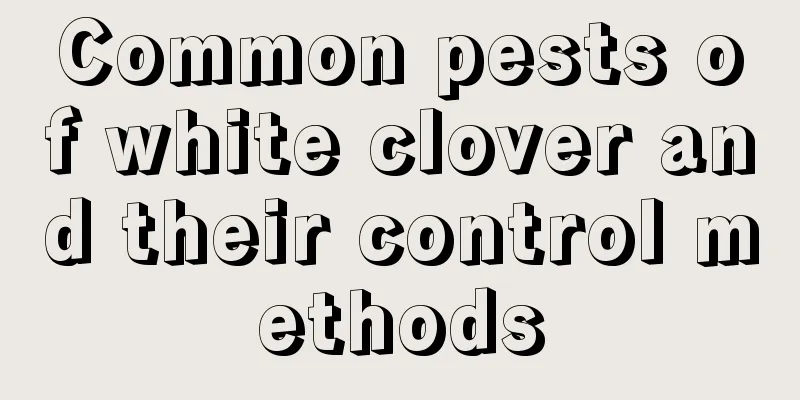Common pests of white clover and their control methods

Common pests of white clover: leafhoppersPest symptomsThe larvae and adults mainly live on the back of leaves and suck the leaf juice. In mild cases, the leaves turn green and small white spots appear on the leaves. In severe cases, the leaves turn pale and their ornamental value is greatly reduced. Prevention and treatment methodsCheck in late April. If larvae are found, spray with 1500 times diluted 50% carbofuran or 2000 times diluted pyrethroid pesticide. The spray should be evenly distributed on the leaves, back of leaves, and inside and outside of the plant. Common pests of white clover: white butterflyPest symptomsOne of the major pests of white clover. From April to October every year, white cabbage butterfly larvae often damage the leaves. The disease is most serious in the dry, hot and rainy summer season, when the larvae can eat all the leaves. The growth potential of affected plants is weakened. Prevention and treatment methodsDuring the larval stage, you can spray green worm fungus to kill them. You can also sprinkle 2.5% dichlorvos powder in the morning before the dew dries. Common pests of white clover: cutwormsPest symptomsIn early spring, the damage to roots and buds is particularly severe in sandy soil. Some of the damage is done by biting off the rhizomes on the ground, while others eat the sprouts from underground, causing the death of large numbers of plants. Prevention and treatment methodsIn addition to the commonly used venom trapping, furadan granules can be applied in ditches or holes, with a dosage of 1500-2000 grams per mu. This drug has a long residual effect and can prevent harm 7-8 weeks after application. Common diseases of white clover: Spodoptera lituraPest symptomsOne of the main pests of white clover. They hide during the day and are active at night. At 1-2 years old, they feed on leaf flesh. At 3-4 years old, they nibble away at the leaf edges, leaving notches. At 5-6 years old, they reach the gluttonous stage, nibbling away at the leaves and even eating them completely. This insect has the property of feigning death, and its larvae have the habit of burrowing in the soil (1-2 cm). Rainfall is beneficial to it, while heavy rain or the invasion of cold air is not favorable to it. Prevention and treatment methodsThe most suitable growth temperature for Spodoptera litura is 15-25℃. Pesticides can be sprayed in the evening or morning. 2.5% trichlorfon powder and 5% carbofuran powder can be used at 22.5-30kg/hectare. You can also use 90% trichlorfon crystals 1000-1500 times diluted, 50% dichlorvos emulsion 1000-2000 times diluted, 50% carbofuran emulsion 1000 times diluted 50-100kg/mu for spraying. |
<<: Common Pests of Purple Jasmine and Their Control Methods
>>: Diseases and pests of red spider lily and their control methods
Recommend
What are the 5 kinds of grains?
1. Xiaomi Millet has high nutritional value, cont...
When is the best time to prune elm bonsai?
The role of elm bonsai pruning The main purpose o...
What should I do if the green bell grows too long?
The reason why the green bell grows too long Spri...
What plants are good to plant at home?
1. Clivia Clivia is a spiritual plant that can pr...
Cucumber planting time and method
Cucumber planting time Cucumbers are generally pl...
Can strawberries be planted all year round? Which season is best for planting?
China ranks first in the world in terms of strawb...
Which plants have special functions?
1. Dracaena The dragon blood tree can bleed, so i...
Can the spider plant survive if its leaves wilt?
1. Can I still live? Chlorophytum is a plant with...
How long does it take for clematis to bloom? How long does it take from germination to flowering?
How long does it take for clematis to bloom? From...
The 8 most beautiful hanging flowers in the world will drive you crazy at first sight!
1 Peony Flowering period: April-June The flowers ...
Cultivation method of Daphne odora
1. Soil To grow Daphne koreana, you need to use f...
How many days is the growing period of lettuce?
There are four stages in the growth process of le...
Keep a pot of it at home, hang red lanterns on its branches, and celebrate the New Year with prosperity!
I have a pot of fuchsia at home, and one of them ...
If you don't prune now, your flowers will soon die.
Gardenia Cut off branches that grow too fast. Som...
How to plant litchi seeds? Can potted plants bear fruit?
1. How to plant litchi seeds It is recommended to...









